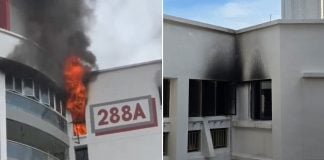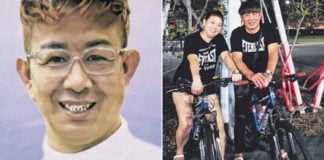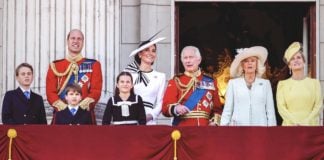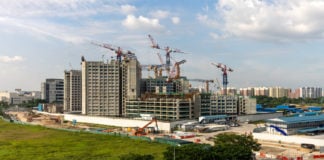Prime Ministers of Singapore so far, from 1959 to present
Singapore has had three prime ministers in its history.
Come 15 May, the nation will welcome its fourth when Prime Minister (PM) Lee Hsien Loong passes the reins to Finance Minister and Deputy Prime Minister (DPM) Lawrence Wong.
The Prime Minister’s Office (PMO) announced the news on Monday (15 April).
PM Lee has also expressed that once he vacates his position, he will still “be at the new PM’s disposal” and “go wherever [the new PM] thinks [he] can be useful.”
In light of the upcoming historic transition, MS News takes a look at Singapore’s Prime Ministers through the years — Lee Kuan Yew, Goh Chok Tong, and Lee Hsien Loong.
1959 to 1990: Lee Kuan Yew, the first of Singapore’s prime ministers
The late Mr Lee Kuan Yew was among the founding members of the People’s Action Party (PAP), and was Singapore’s first and longest-serving PM to-date.
He was in office from 5 June 1959 to 28 Nov 1990, with his premiership beginning even before the country was independent.
The late Mr Lee was only 35 years old when he took on the heavy role.

Source: Getty Images via The New York Times
Prior to the Japanese Occupation of Singapore during World War II, Mr Lee attended Raffles Institution, before enrolling at Raffles College on scholarship.
After the War, he studied at the London School of Economics in 1946. However, he later transferred to Fitzwilliam Hall at Cambridge University in early 1947.
It was Mr Lee’s time in the United Kingdom (UK) that drew him into politics. He was involved with the British Labour Party and participated in London’s Malayan Forum, which was a discussion group for Malayan students.
He graduated with a first-class law degree in 1949, and was called to the bar at London’s Middle Temple a year later.
Mr Lee then returned to Singapore to practise law.
How Lee Kuan Yew became prime minister in 1959
In 1954, Mr Lee became one of the founders of the People’s Action Party (PAP).
Himself, alongside Toh Chin Chye, Goh Keng Swee, and later S Rajatratnam, are known to be the founding members of the political party.
While Mr Toh Chin Chye was the founding Chairman, Mr Lee was PAP’s Secretary-General — a position he held till 1992.
PAP participated in its first political contest in April 1955 at the Singapore Legislative Assembly election.
There, Mr Lee won his seat in the Tanjong Pagar division, reported The Straits Budget.
Following which, the 1959 General Election was a watershed moment for the PAP.
The party — led by 35-year-old Mr Lee — captured 43 of the assembly’s 51 seats after a landslide victory at the polls on 30 May that year.

Source: Associated Press via The Wall Street Journal
On the morning of 1 June 1959, former Chief Minister Mr Lim Yew Hock resigned from his post. Mr Lee visited Governor William Goode that same morning to discuss the new government.
As a result, observers noted that Mr Lee was poised to be Singapore’s Prime Minister, reported The Singapore Free Press.
True enough, Mr Lee was announced as Singapore’s first PM on 2 June 1959.
“I have been invited to form the government,” said Mr Lee to reporters.
“If the conditions which I indicated to the Governor are accepted, I would accept the responsibility of forming a government.”
Spearheaded Singapore’s merger with Malaysia in 1963
The new PM’s work was only just beginning. Now, he had to start building the nation.
Most memorably, he fought for the merger of Singapore and Malaya — iconically broadcasted on Radio Singapore in 1961.
In September 1963, Mr Lee won a referendum on the terms of the merger, and Malaysia was formed with the merger of Malaya, Singapore, Sabah, and Sarawak.
The same year, the PAP emerged victorious after a fierce battle during the 1963 General Elections. Mr Lee remained as the PM of Singapore, and became a member of Malaysia’s federal parliament.
Alas, Singapore subsequently separated from Malaysia on 9 Aug 1965 due to tensions with the Federal Government.
Mr Lee described the separation as a “moment of anguish”, as he tearfully delivered the separation announcement in a televised speech that day.

Source: National Archives of Singapore
Despite the setback, Mr Lee did not let it impact his vision for Singapore. In September 1965, he said in a speech that is now famous among Singaporeans:
Over 100 years ago, this was a mudflat, swamp. Today, this is a modern city. Ten years from now, this will be a metropolis. Never fear.
As the first PM of Singapore, the late Mr Lee pushed Singapore to be the metropolis that he promised.
He was instrumental in the creation of Singapore Airlines and the development of Changi Airport, and remained a formidable political force over the years.
Under him, the PAP won six general elections post-independence.
He officially stepped down a few months after Singapore’s 25th National Day in 1990, passing the baton to Goh Chok Tong.
Mr Lee went on to become Senior Minister and subsequently, Minister Mentor, a position he held until 2011. He died on 23 March 2015.
1990 to 2004: The Goh Chok Tong era
Mr Goh Chok Tong served as Singapore’s second PM. He was in office from 28 Nov 1990 to 11 Aug 2004.
Following Mr Lee Kuan Yew’s resignation as Singapore’s PM, Mr Goh was sworn in as the country’s premier at 49 years old.

Source: National Archives of Singapore
The University of Singapore alum joined the Administrative Service of the Singapore Government in 1964 after graduating with First Class Honours in Economics.
After a stint in the Economic Planning Unit and a secondment with national shipping company Neptune Orient Lines from 1969 to 1977, he joined politics and became the Member of Parliament (MP) for the Marine Parade constituency.
How Goh Chok Tong became LKY’s successor
In the years leading up to his premiership, Mr Goh was the Senior Minister of State for Finance, before subsequently helming the portfolios of the Ministry of Trade and Industry, Ministry of Health, and Ministry of Defence.
In a 2017 interview with Digital Narratives of Asia, Mr Goh said that joined politics to serve the country, not for the power of being prime minister.
However, he was eventually one of the few candidates — though not the top choice.
“So he [Mr Lee] told me quite frankly that he preferred Dr Tony Tan to be the prime minister,” said Mr Goh, after noting that he and Mr Lee had a “very good relationship” where they were “frank” and “candid” with one another.
“And he gave his reasons and why I was the second choice. So, we just accepted it.”
The Straits Times (ST) reported that the decision to appoint Mr Goh was made after dinner at then Finance Minister Tony Tan’s home in Bukit Timah in 1984.
Mr Tan had made it clear at the dinner that he would not want to be leader, said the ST report, and the group decided Mr Goh was the next best candidate. He accepted it.
Shortly after, in 1985, Mr Goh was appointed Deputy Prime Minister.
In 1990, he became the second Prime Minister of Singapore.
Set up consultative channels between the people and the Government
As PM, Singaporeans came to know Mr Goh’s leadership style as more consultative.
“I was not Lee Kuan Yew,” he said in a 2017 interview. “I decided I could not govern Singapore as a Lee Kuan Yew.”
Apart from staying true to his affable personality, Mr Goh adopted the consultative approach as Singapore was in a different era.
“By my time, when I took over, Singapore was a middle-income country,” shared Mr Goh.
“We were still emphasising economic growth, trying to improve people’s lives, but not struggling to survive.”
As such, he decided to engage Singaporeans — particularly, the middle class.
Even as an MP, Mr Goh established Residents’ Committees (RCs) in his constituency in 1977 to serve as a bridge between residents and the Government.
In March 1985, he set up the Feedback Unit to better involve Singaporeans in the policy-making process.
On top of that, Mr Goh introduced several measures to address Singapore’s education levels and income inequality such as:
- Edusave scheme in 1993
- Skills Redevelopment Programme in 1996
- PRIME (Programme for Rebuilding and Improving Existing Schools) in 1999
- Singapore Workforce Development Agency in 2003
- Home Ownership Plus Education scheme in 2004
In July 2004, after 14 years in the role, Mr Goh announced his intention to resign as PM.
Mr Goh officially tendered his resignation to then-President S. R. Nathan on 10 August 2004, following a moving tribute to the PM’s years of service at the National Day Parade that year.
He remained in Cabinet as a Senior Minister until leaving Cabinet in May 2011, when he received the honorary title of Emeritus Senior Minister.
2004 to 2024: Lee Hsien Loong
Mr Lee Hsien Loong is Singapore’s third PM, and has been in office since 12 Aug 2004. He intends to step down from the premiership in favour of Deputy Prime Minister and Finance Minister Lawrence Wong on 15 May 2024.

Source: PTI via Deccan Chronicle
In his formative years, PM Lee studied at Nanyang Primary School and Catholic High School.
Before joining politics, he graduated with a Bachelor of Arts in Mathematics and a Diploma in Computer Science from the University of Cambridge. Later, he was a Mason Fellow at the Harvard Kennedy School, where he received a Master degree in Public Administration.
He had also served in the Singapore Armed Forces (SAF), retiring as a Brigadier-General in 1984.
Became MP at 32 with Teck Ghee SMC in 1984
Not an unfamiliar face to Singaporean politics, Mr Lee Hsien Loong was already a core member of the next batch of new leaders during the leadership transition that followed Mr Lee Kuan Yew’s announcement that he would step down as PM in 1984.
The same year, Mr Lee Hsien Loong won the Teck Ghee single member constituency (SMC) seat and became a Member of Parliament at 32 years old.
Subsequently, he went on to hold various appointments such as Minister for Finance, Minister for Trade and Industry, and Second Minister for Defence.
He also became the chairperson of the PAP Youth Wing (now Young PAP) when it was formed in 1986, under the guidance of Mr Goh.
The duo has a healthy relationship, as summed up in a Facebook post by PM Lee in 2020 following Mr Goh’s retirement from politics.
“I am forever personally indebted to Chok Tong, who brought me into politics,” shared PM Lee.
“Ours was a fruitful comradeship that spanned the entirety of my years in politics and most of his — a close friendship between two prime ministers that would be the envy of many countries.”
Appointed as DPM when Goh Chok Tong became PM in 1990, succeeded him in 2004
PM Lee Hsien Loong became the DPM, along with Ong Teng Cheong, when Mr Goh became PM in Nov 1990.
During that period, then-DPM Lee continued to serve as the Minister for Trade and Industry until 1992, when he relinquished that position after he was diagnosed with lymphoma.
However, he continued to be a DPM during his illness.
He underwent three months of chemotherapy, which proved successful, and his cancer has since gone into remission.
On 12 Aug 2004, Mr Lee Hsien Loong succeeded Mr Goh Chok Tong as PM of Singapore, following the latter’s resignation.

Source: Prime Minister’s Office
During his first National Day Rally speech on 22 Aug 2004, PM Lee introduced several new initiatives, which included the five-day work week, doing away with the half-working day on Saturdays.
He also extended maternity leave from eight to 12 weeks, and expanded the Baby Bonus scheme to cover women who bear a fourth child.
In subsequent years, PM Lee launched SkillsFuture to support Singaporeans in embracing lifelong learning and skills, as well as the Smart Nation initiative to use technology to create a future of better living, more opportunities, and stronger communities.
At the same time, PM Lee holds the role of the Secretary-General of the PAP. Under his leadership, PAP won four consecutive Singapore General Elections victories in 2006, 2011, 2015 and 2020.
Additionally, he has been re-elected as MP eight times, most recently for the Ang Mo Kio GRC.
For DPM Lawrence Wong, it remains to be seen how he will leave his own unique mark in Singapore’s history.
Have news you must share? Get in touch with us via email at news@mustsharenews.com.
Featured image adapted from Getty Images via CNBC, Institute of Policy Studies, and Tatler Asia.








